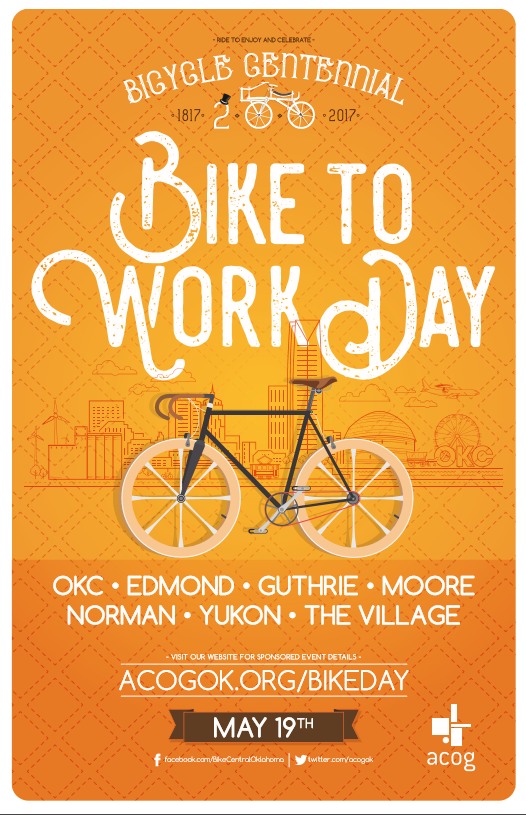Guest Post by Charlotte Adcock, Assistant Planner – Multimodal
Ride the City
So maybe you’re thinking about riding your bike around town. Work might be too far for you, but that one store is right down the street. Maybe you can start there. But cycling is expensive, right? It doesn’t have to be. When you learned to ride a bike as a kid, were you dressed in spandex and clip shoes? No! You were probably outside in a t-shirt and shorts riding around in circles on the driveway. All those bells and whistles are there to make the ride smoother, but they are not necessary. So, what do you need to know?
The Equipment
In order to cycle as a mode of transportation, you need a few things first. First, you obviously need a bike. But with all the types of bikes out there, how do you know which is right for you? If you are just testing the waters, a basic bicycle from Target or Wal-Mart may be enough. If you’re more interested in riding regularly, it is better to go to your local bike store to get the proper bike. Those at the several bike shops around the region will be able to get you set up with the perfect bike as well as any other equipment you would need.
Besides the bike, you should also get a helmet, as well as a set of lights for when you ride in the rain or at night. If you need to carry things, consider a taking a backpack with everything you might need – lunch, water, change of clothes, maybe your laptop – or a panier bag that would clip onto a rack on the back of the bike.
Rules of the Road for Cyclists
Before you even get out on the streets, it is important to know the laws that apply to cyclists. There are a handful of laws in Oklahoma regarding the safe travel of cyclists. This is a list of a few of them. For more, visit the Oklahoma State Courts Network.
Traffic laws apply to persons riding bicycles.
This means that the cyclist has the same rights and responsibilities as a motor vehicle driver, except when specifically stated otherwise or if those provisions have no application to a bicycle. (Title 47 § 11-1202)
Bicyclists must obey all traffic control devices and signs.
(Title 47 § 11-201) As a vehicle, a cyclist must stop at a stop sign and wait at a red traffic light. Oklahoma does not have an ‘Idaho Stop’ law, which permits cyclists to treat stop signs as yield signs and stop lights as stop signs.
Signal your intention to turn, slow down, or stop.
When turning, must signal continuously for at least 100 feet before the turn as well as when you are stopped, unless the use of your hand is needed to control the bicycle. (Title 47 § 11-606)
- To turn left, extend your left arm horizontally.
- To turn right, extend your left hand upward, bent at the elbow (note that in some areas of the U.S. cyclists may extend their right arm horizontally to signal right, however there is nothing specifically stating this is compliant with Oklahoma law).
- To signal stopping or slowing down, extend your left hand downward with your elbow bent. (Title 47 § 11-606)
No person riding upon any bicycle…shall attach the same or himself or herself to any vehicle upon a roadway.
Using a motor vehicle to pull or propel a bicycle is extremely dangerous! (Title 47 § 11-1204)
Every person operating a bicycle upon a roadway shall ride as close as is safe to the right-hand curb or edge of the roadway.
There are some exceptions to this law:
- When overtaking and passing another vehicle (such as another cyclist or a pedestrian) proceeding in the same direction;
- When preparing for a left turn at an intersection or into a private road or driveway;
- When reasonably necessary to avoid conditions and while exercising due care;
- When riding in the right-turn-only lane (Title 47 § 11-1205)
Persons riding bicycles shall not ride more than two abreast except in areas designated as exclusive for cyclists. (Title 47 § 11-1205)
No person operating a bicycle…shall carry any package, bundle or article which prevents the rider from keeping at least one hand upon the handle bars. (Title 47 § 11-1206)
Oklahoma also has a ‘3-foot law.’ When overtaking and passing a bicycle proceeding in the same direction, a person driving a motor vehicle shall…leave a safe distance between the motor vehicle and bicycle of not less than three (3) feet. Failure to comply with this law that results in serious physical injury of the cyclist due to collision, subjects the driver to a maximum fine of $500.00. Should a collision result in the death of the cyclist, the driver is subject to a maximum of $1,000.00, in addition to other penalties prescribed by law. (Title 47 § 11-1208)
Helmets
Protect your noggin! Always wear a helmet, especially if you intend to ride on the side of the road. Look for helmets that are approved and have a SNELL, ASTM, or SEI sticker. If you are concerned about the perceived cost of purchasing a helmet, think of it this way: a visit to the emergency room could cost more than 10 times the price of a single helmet. And remember: helmets have a limited life. If you have crashed or dropped the helmet, resulting in cracked foam, it is time to replace it.
When riding at night, be sure your bike is equipped with a headlamp and rear red reflector, at minimum. While no longer required by state law, lights may be required by your local city ordinances. It’s also a good idea to wear bright colors and reflective gear.
Take to the Streets
Now that you have a bike and understand some of the laws that apply to you as a cyclist, there is only one thing left to do: plot your journey. What is the safest and fastest route to your destination? You can of course use Google Maps. There is a feature that will help you find the quickest route to your destination that is safe for a bike rider. However, there are a few more local alternatives:
ACOG’s regional bicycle facilities map
Edmond
Norman
Oklahoma City
The Oklahoma Bicycle Society also has a map you can print off here for Oklahoma City trails.
Are You Comfortable Riding?
What it comes down to is this: Where are you comfortable riding? Here are a couple of tips to think about when plotting your route:
Consider the distance and the volume of traffic on the streets. Sometimes the most direct route is not the safest or most pleasant by bike. Arterials may be easy and fast by car, but would you feel comfortable riding it by bike?
Take the scenic route through quieter neighborhood roads. Even if there are no signs or markings dedicated to cyclists, the speed limits are low enough to safely share the road with motorists.
Conduct a test run on the weekend. If you’re worried about making it to work on time, trying the ride out on the weekend will let you see how long it will take you. Plus, you won’t have to deal with the rush hour volumes on that first run through.
Arrival
You made it! Now you just need somewhere to park. It can be frustrating to arrive at your destination only to find there are no bike racks to safely store your bike. After all, employers pay hundreds or sometimes thousands of dollars for those automobile parking spaces. If you’re arriving at work, perhaps your employer will allow you to bring it inside and store it somewhere safe. If your destination is a commercial center or your employer will not allow you to bring your bike inside, just be sure to lock up somewhere visible with plenty of pedestrian traffic.
With your bike locked up, you head inside. While the exercise makes you feel good, the Oklahoma summer heat starts early in the morning. It’s likely you arrived more than a little sweaty. If your workplace doesn’t have a shower on site, what should you do? You can’t go to that early morning meeting drenched in sweat! Even if there are no shower facilities on site, you can still freshen up in the bathroom. Baby wipes and some hand sanitizer will help with the odor and cool you down.
Do you have other tips and tricks you would like to share with other interested cyclists? Share them with us on Facebook!
Sources:
http://www.oscn.net/applications/oscn/Index.asp?ftdb=STOKST47&level=1
http://bikeleague.org/content/commuting The Oklahoma Bicycle Manual from ODOT (circa 2003)

